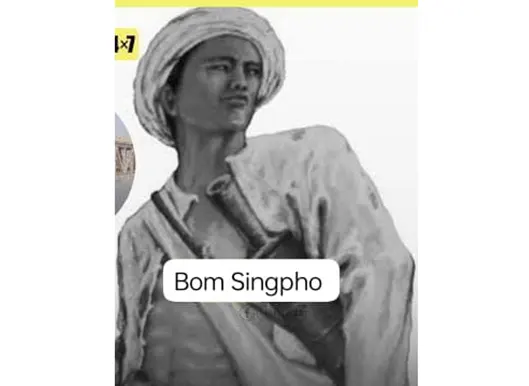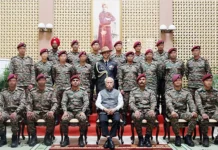[ Pisi Zauing ]
BORDUMSA, 22 Oct: Nearly two centuries ago, in the mist-draped valleys of the Patkai Hills, a warrior named Bom Singpho rose against the might of the British Empire. In 1830, when the shadow of colonial power began to creep across the Northeast, Bom Singpho, Chief of his clan and guardian of his people’s pride, led a fierce uprising from the dense bamboo forests of what is now Margherita in Assam’s Tinsukia district, bordering Arunachal Pradesh.
For the Singpho community of Arunachal and Assam, his name became more than a memory – it became a song, a story told by firelight, woven with courage, dignity, and defiance.
Yet, in the vast annals of India’s freedom struggle, the tale of Bom Singpho slowly faded into the footnotes of history, remembered only by his descendants and by the hills that once echoed his call.
The long-awaited proposal to build the Bom Singpho Memorial Ladoi Ghat bridge at Inthem in Margherita subdivision has stirred renewed hope – and tears of gratitude – among the Singpho people. The bridge, envisioned to span the turbulent Buridehing river, is not merely a structure of steel and stone, but a tribute and a reminder that India’s freedom was fought for in every corner of the land, even from the quiet, mist-laden folds of the Northeast.
Bhogeswar Shyam, retired secretary of handloom and textiles, government of Assam – a man long admired for his enduring bond with the Singpho community – took upon himself the noble task of ensuring due recognition to one of Northeast India’s unsung heroes. Treating it as a mission of conscience, Shyam petitioned the National Commission for Scheduled Tribes (NCST) to sanction the long-awaited project.
In his heartfelt appeal, he underscored that Bom Singpho, who stood up against British authority decades before the revolt of 1857, remains “a forgotten sentinel of India’s freedom whose story deserves the nation’s respect.”
Calling for remembrance as much as for restoration, Shyam further drew the attention of the NCST to the Bom Singpho Bhawan, constructed in 1995 at Inthem with Rs. 2.5 lakh from the MP local area development fund of Bolin Kuli – a structure that today stands as a silent relic of neglect.
Once envisioned as a monument of pride, the Bhawan now lies abandoned, its walls weathered and crumbling under years of indifference.
“The time is now ripe to restore not only the building, but the honour it represents,” Shyam urged.
Following his earnest plea, the proposal for the Bom Singpho Memorial bridge was formally forwarded to the NCST through the office of the Tinsukia district commissioner.
In response, Dr. P. Kalyan Reddy, director of the NCST, has sought a detailed project report and a comprehensive roadmap for its implementation – a development that rekindles hope among the Singpho community for long-overdue recognition of their valiant ancestor.
In Bisa Gaon, Ledo, nestled along the historic Stilwell Road and home to the descendants of Bom Singpho, the news was received with quiet emotion by community members, young and old, men and women alike.
“We have waited generations for this day. The Buridehing River that once carried his courage will now carry his name,” said Bisa Laseng Rajkumar, great-grandson of Bom Singpho.
Calling the proposed bridge a living monument to the unsung freedom fighter who gave whatever he had, including his life, for dignity and homeland, the entire Singpho populace of Assam and Arunachal Pradesh has extended heartfelt gratitude to the government of Assam, the NCST, and all those who supported the cause.
Once completed, the Bom Singpho Memorial Bridge will not merely connect the two banks of the Buridehing; it will connect the past with the present, remembrance with recognition.
And as the evening sun glows upon its waters, the people of the region will know that, at last, their warrior’s spirit has crossed over – from legend into history.


